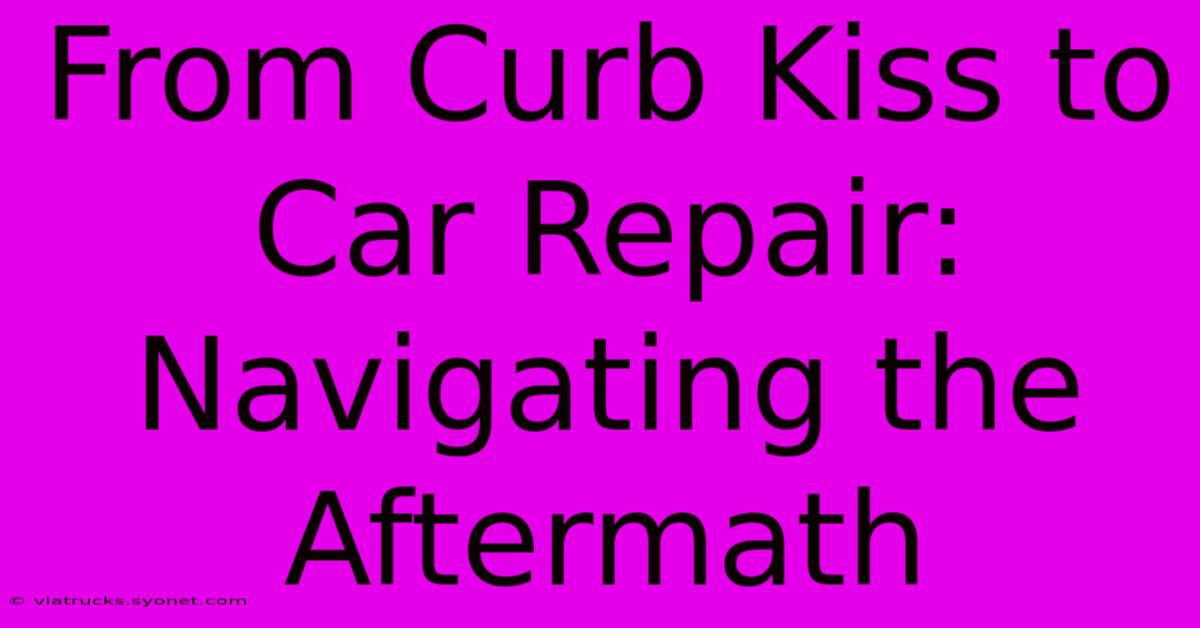From Curb Kiss To Car Repair: Navigating The Aftermath

Table of Contents
From Curb Kiss to Car Repair: Navigating the Aftermath
So, it happened. That dreaded "curb kiss"—a seemingly innocent scrape that quickly morphs into a significant dent, a shattered headlight, or worse. Your once-pristine vehicle now bears the battle scars of an unfortunate encounter with, well, a curb. Don't panic! This guide will walk you through the steps to navigate the aftermath of your vehicular mishap, from initial assessment to final repair.
Assessing the Damage: More Than Just a Scratch?
Before you even consider contacting your insurance company or a repair shop, take a thorough assessment of the damage. This is crucial for several reasons:
- Document Everything: Take clear, well-lit photos from multiple angles. This documentation is vital for insurance claims and helps you understand the extent of the damage. Include close-ups of any scratches, dents, cracks, or broken parts.
- Identify the Affected Areas: Is it just cosmetic damage (scratches and dents), or are there more significant issues like a bent frame, damaged suspension, or malfunctioning headlights? Note all affected components.
- Check for Safety Hazards: If any safety features are compromised—like airbags, seatbelts, or lights—get your car towed immediately and prioritize safety. Don't drive a vehicle that's potentially unsafe.
Beyond the Obvious: Hidden Damage
Remember, curb damage isn't always immediately apparent. A seemingly minor scuff could mask underlying damage to the wheel alignment, suspension, or even the frame. A professional assessment is essential to uncover hidden problems that could impact your vehicle's performance and safety in the long run.
Reporting to Insurance: What You Need to Know
Your next step depends on your insurance coverage and the severity of the damage.
- Contact Your Insurance Provider: Report the incident promptly. They will guide you through their claims process and may require you to submit the photos you took. Be prepared to provide details about the location, time, and circumstances of the incident.
- Understand Your Deductible: Know your deductible amount upfront. This is the amount you'll have to pay out-of-pocket before your insurance coverage kicks in.
- Consider the Cost of Repair: Weigh the cost of repair against your deductible. If the repair costs less than your deductible, it might be more cost-effective to pay for the repairs yourself.
Choosing a Repair Shop: Finding the Right Fit
Selecting a reputable repair shop is critical to ensuring quality repairs and a smooth process.
- Check Reviews and Ratings: Look for online reviews and ratings on sites like Yelp or Google My Business. Positive reviews and high ratings indicate a reliable and trustworthy shop.
- Seek Recommendations: Ask friends, family, or colleagues for recommendations based on their experiences. Word-of-mouth referrals can be invaluable.
- Get Multiple Quotes: Obtain quotes from at least three different repair shops to compare prices and services. Ensure that all quotes include a detailed breakdown of the costs.
The Repair Process: What to Expect
Once you've chosen a repair shop, the repair process usually involves:
- Initial Assessment: The shop will assess the damage and provide a detailed estimate of the repair costs.
- Parts Ordering: If parts need to be replaced, the shop will order them from the manufacturer or a reputable supplier. This can take some time.
- Repair Work: The actual repair process will take place. This involves straightening dents, replacing broken parts, repainting, and ensuring everything is functioning properly.
- Final Inspection: Once the repairs are complete, the shop will conduct a thorough inspection to ensure everything is working correctly.
Beyond the Repairs: Preventing Future Curb Kisses
Learning from mistakes is crucial. Here are some tips to help you avoid future curb encounters:
- Practice Safe Driving: Pay close attention to your surroundings and maintain a safe following distance.
- Park Smart: Choose parking spots that provide ample space and avoid parking too close to curbs.
- Be Mindful of Your Surroundings: Especially in tight spaces, take your time and be extra cautious when parking or maneuvering your vehicle.
By following these steps, you can navigate the aftermath of your curb kiss with confidence and get your vehicle back on the road safely and efficiently. Remember, thorough documentation, a professional assessment, and careful selection of a repair shop are key to a successful outcome.

Thank you for visiting our website wich cover about From Curb Kiss To Car Repair: Navigating The Aftermath. We hope the information provided has been useful to you. Feel free to contact us if you have any questions or need further assistance. See you next time and dont miss to bookmark.
Featured Posts
-
Mechanical Electrical Room Makeover Worth It
Feb 09, 2025
-
Butler Curry Show Early Court Synergy
Feb 09, 2025
-
Messi Se Doelpunt En Assist Miami Wen
Feb 09, 2025
-
Man City Qualification Difficile En Coupe
Feb 09, 2025
-
Build Your Own Little House In The Big Woods A Step By Step Guide
Feb 09, 2025
